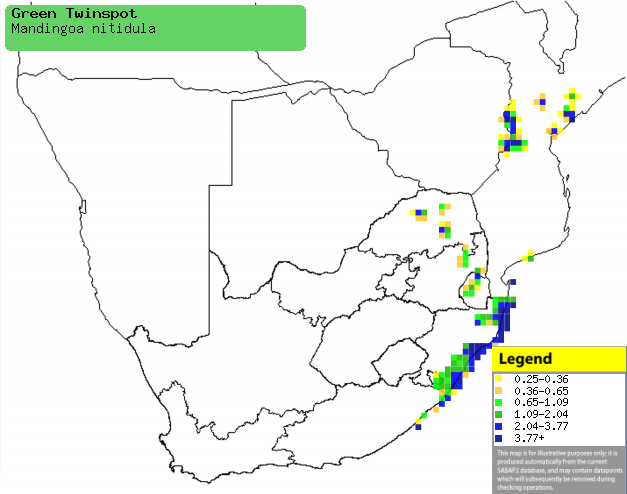|
Mandingoa nitidula (Green
twinspot)
Groenkolpensie [Afrikaans]; Groene druppelastrild [Dutch];
Sénégali vert [French]; Grüner tropfenastrild [German];
Pintadinha-verde [Portuguese]
Life
> Eukaryotes >
Opisthokonta
> Metazoa (animals) >
Bilateria >
Deuterostomia > Chordata >
Craniata > Vertebrata (vertebrates) > Gnathostomata (jawed
vertebrates) > Teleostomi (teleost fish) > Osteichthyes (bony fish) > Class:
Sarcopterygii (lobe-finned
fish) > Stegocephalia (terrestrial
vertebrates) > Tetrapoda
(four-legged vertebrates) > Reptiliomorpha > Amniota >
Reptilia (reptiles) >
Romeriida > Diapsida > Archosauromorpha > Archosauria >
Dinosauria
(dinosaurs) > Saurischia > Theropoda (bipedal predatory dinosaurs) >
Coelurosauria > Maniraptora >Aves
(birds) > Order: Passeriformes
> Family: Estrildidae
Distribution and habitat
Occurs in patches of sub-Saharan Africa, from West Africa
to much of the DRC and surrounding countries, extending south to southern
Africa. Here it is uncommon to locally common in Zimbabwe's eastern highlands
and adjacent central Mozambique, with a separate population in eastern South
Africa and Swaziland, from Limpopo province to KwaZulu-Natal and marginally in
the Eastern Cape. It generally prefers edges of forest, especially with tangled
bracken-brier scrub or gardens, also occupying alien tree plantations,
particularly with patches of Ribbon bristle grass (Setaria chevalieri).
|
 |
|
Distribution of Green twinspot in southern Africa,
based on statistical smoothing of the records from first SA Bird Atlas
Project (©
Animal Demography unit, University of
Cape Town; smoothing by Birgit Erni and Francesca Little). Colours range
from dark blue (most common) through to yellow (least common).
See here for the latest distribution
from the SABAP2. |
Food
It mainly eats seeds taken from the ground or directly from
plants, especially grasses, supplemented with small insects. The following food items have been recorded
in its diet:
- Seeds
- grasses
- Oplismenus hirtellus (Basket grass)
- Setaria chevalieri (Ribbon bristle grass)
- Sacciolepis curvata (Forest hood grass)
- Urera cameroonensis (Creeping stinging nettle)
- Insects
Breeding
- The nest is built by both sexes, consisting of a bulk oval ball with a
small entrance spout, made of grass stems, skeletonised leaves, rootlets,
twigs and old-man's-beard lichen (Usnea) and lined with feathers,
fine grass and other soft material. It is typically concealed in the canopy
of a tall tree, but it may rarely use an abandoned
Dark-backed weaver nest
instead of building its own.
- Egg-laying season is from December-April in KwaZulu-Natal.
- It lays 4-6 eggs, which are incubated by both sexes for about 12-14
days.
- The chicks are fed by both parents, leaving the nest after about 17 days
and becoming independent about a week later.
Threats
Not threatened, but overgrazing of grass and trapping for
the cage-bird trade are cause for concern.
References
-
Hockey PAR, Dean WRJ and Ryan PG 2005. Roberts
- Birds of southern Africa, VIIth ed. The Trustees of the John Voelcker
Bird Book Fund, Cape Town.
|
